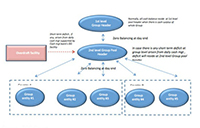Managing Cash by Managing the Supply Chain: Part 1
Stanley Tan, who heads the Working Capital Advisory Team at DBS Bank Global Transaction Services (GTS), shares his view. In Part 1, he takes a look at the alignment of a firm’s physical and financial supply chain and its cash conversion cycle.

Since the Global Financial Crisis of 2008-09, there has been a renewed emphasis on the quality and sustainability of earnings. Beyond top-line revenue growth, management and investors alike have focused on the quality of free cash flows and internal efficiencies as a source of competitive advantage and value creation. In particular, working capital management and the ability to optimise cash conversion cycle (CCC) times have become increasingly important.
A firm’s cash conversion cycle (CCC) time can be broken down into its constituent drivers: Days Sales Outstanding (DSO), Days Inventory Outstanding (DIO) and Days Payables Outstanding (DPO). CCC time provides a measure of how long it takes for a firm to convert cash outflows (i.e. investment) back into cash receipts (i.e. returns/profits). It is typically measured in days via: CCC = DSO + DIO – DPO. All things being equal, a shorter CCC is preferable to a longer CCC as it means more efficient use of capital.
However, CCC times will vary widely across industries and geographies and should be understood in context. Different sectors will have different business cycles/models and this will be reflected in CCC times. Likewise, nuances in geography, business culture and infrastructure - both in the physical and financial supply chain - will result in varying CCC times. Where possible, ‘like-for-like’ comparisons are preferred. For example, one might compare a company’s CCC over time as an indication of operational efficiency. Alternatively, one might compare a company against its industry or its peers to analyse differences in strategy or business models.
A quick look at the CCC times of the retail sector over the last six years shows that overall CCC times have trended up. According to data from CapitalIQ, average CCC times have increased from 44 days to 47 days*. The increase is driven by retailers in Asia, with average CCC times increasing from 25 days to 33 days while Europe (51 days) and US (69 days) have seen relatively little change. Among Asian retailers, the increase in CCC is largely driven by an increase in inventory days, from 46 days to 56 days today.
Alignment of the physical and financial supply chains
One explanation for Asian retailers having lower CCC times could be the proximity of their manufacturing base - often in Asia itself - to their end markets. Indeed, the top quartile DIO for Asian retailers was just 27 days, compared to Europe (35 days) and US (59 days). It highlights the convergence of the physical and financial chain and the need for chief financial officers (CFOs) and treasurers to understand and consider both when looking to optimise CCC times.
It is worth noting that ‘optimised’ CCC times does not always necessarily mean shortest CCC times as strategic, risk and other business considerations need to be factored in. However, knowledge of the financial supply chain helps to shape a robust, strategic physical supply chain and CFOs/treasurers are uniquely placed to add value.
For example, a US retailer could choose to source its products from a low-cost Asian supplier. In doing so, it saves on direct cost but increases its DIO times. A proactive CFO/treasurer would validate the net benefit, and explore potential financial solutions such as supply chain financing (SCF) to lengthen DPO, shorten CCC times, and effectively negate the increase in DIO.
*All CCC data from Capital IQ; includes companies classified under 'retailing' industry, with revenues US$50m and above, and primarily located in Asia Pacific, Europe or US/Canada
Subscribe to DBS BusinessClass
Stay updated with the latest market trends and industry insights, connect with a network of entrepreneurs, and gain access to exclusive event invitations. Join Asia's fastest growing business community – get your complimentary membership here.




